Spotlight

Why wear a Mask?
COVID 19 virus spreads from person to person direct contact with infected people by respiratory droplet and Indirect contact with surfaces in the immediate environment or with objects used on or coughed on by the infected person.SARS-CoV-2, the virus that causes COVID-19 has been detected aerosols for up to 3 hours and on plastic and stainless steel surfaces for up to three days.(N.ENGL J.Med,2020).Masks lower the chances of coronavirus entering the respiratory system through droplets still in the air from an infected person.
Cochrane Review- A systemic analysis of published studies which found strong evidence during the 2003 SARS epidemic in support of wearing masks. One study of community transmission in Beijing found that “constantly wearing a mask in public was associated with a 70% reduction in the risk of catching SARS”
Analyses show that if 50% of the population were to wear masks, only 50% population would be infected by the virus. Once 80% of the population wears a mask, the outbreak can stopped immediately.( https:pubmed.ncbi.nim.nih.gov/30229968/). Wearing a mask is mainly recommended for people living in densely populated areas across India. CDC may review guidelines and may recommend general mask use to guard against community infection.
Common type of Masks:
- N 95 respirator mask ( with or without breathing valve)
- Triple layer surgical mask
- Homemade ( cotton) mask
1. N 95 respirator mask
What is a respirator?
A respirator is a personal protective device that is worn on the face or head and covers at least the nose and mouth. A respirator is used to reduce the wearer’s risk of inhaling hazardous airborne particles ( including infectious agents), gases or vapors.
N 95 respirators can filter 95% of particles with an aerodynamic diameter greater than or equal to 0.3 and block the viruses.They can help to prevent airborne diseases.” N” indicates “ non oil based uses” and a N 95 mask can be used to protect against non oil based suspended particles, 95 means that the infiltration efficacy is not less than 95%.N 95 mask is mainly used in HCP( Health care personnel).
N 95 respirators come in two types with or without breathing valves’ 95 with breathing valves can make breathing easier in people with chronic respiratory disease, heart disease or other disease with breathing difficulty. Carriers of the virus should wear N 95 respirators without breathing valves to prevent spreading the virus. To keep the sterility of environment, N 95 respirators with breathing valves are not suggested because the wearer may exhale bacteria or viruses.
If worn correctly, filtration efficacy of N 95 mask is superior to triple layer surgical mask. However it does not 100% eliminate the risk of infection.
N 95 must NIOSH / EN 149 FFP2 or equivalent approved for quality. It should have high fluid resistance, good breathability( with an expiratory valve),duckbill/cup-shaped structured design that does not collapse against the mouth.
Difference between N 95/ FFP/KN 95 mask –
|
N 95 |
FFP( Filtering face piece) |
KN 95 |
|
It is one of the ratings specified in the American standard (42 CFR 84).
|
It is used in the UK equivalent as N95. There are three categories-FFP1,FFP2, FFP3. FFP3 provides highest protection. |
It is one of the ratings specified in the Chinese standard ( GB 2626 - 2006) with a filtration efficacy 95%. |
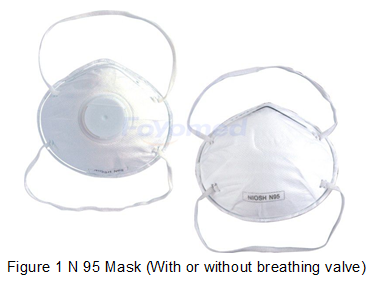
How to wear a N 95 Respirator?-
- Wash your hand with sanitizer or soap and water before putting on mask
- Select N 95 mask that fits you well.
- Hold mask in your hand firmly over nose, mouth and chin
- First, stretch and position bottom band under your ears. Then stretch and position top band high at the back of your head.
- press the thin metal wire along the upper edge gently against the bridge of your nose so that mask fit properly
- Perform a fit check by breathing in and out. Check for air leakage around your face with breathing out.
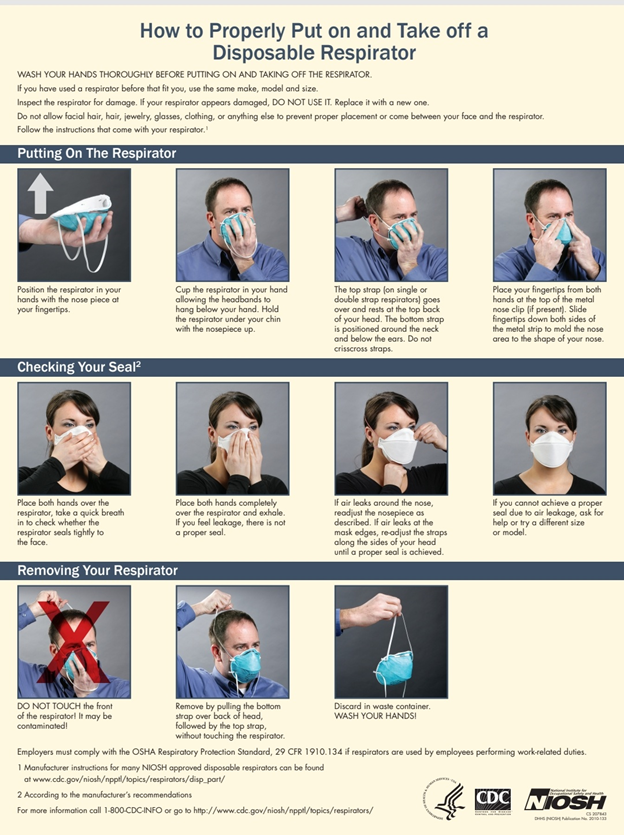
2. Triple layer surgical mask:
Surgical mask have three layers. The outer layer is hydrophobic non-woven layer which prevent droplets from entering the mask, the middle layer has a filter to block 90% of particles with diameter greater than 5 and the inner layer in contact with the nose and mouth absorbs moisture. They prevent airborne infections.
Filtration efficiency of surgical masks is not uniform. Surgical mask is disposable and single use.
The role of surgical masks is for patient source control to prevent contamination of the surrounding area when a person cough or sneezes. Patients with confirmed or suspected COVID 19 should wear a surgical mask until they are isolated in a hospital or at home.( cdc)
Standard surgical masks are as effective as respirator masks ( e.g.N 95,FFP2 & 3 ) for preventing infection of healthcare workers in outbreaks of viral respiratory illness such as influenza.( cov.id/INSERT , Greenhalgh T et al).Official UK guidance released in feb. 2020 claimed that both surgical and respirator masks provide 80% protection against SARS-CoV-2.
However, this claim referenced a 2017 systematic review that was undertaken before the emergence of SARS-Cov-2 and based largely of trials in seasonal influenza.(clinical infectious diseases 2017,65(11):1934-42.

When to use a triple layer surgical Mask by the general public ? ( WHO guideline)
- For healthy people wear a mask only if you are taking care of a person with suspected 2019-nCoV infection.
- Wear a mask, If you are coughing or sneezing.
- Masks are effective only when used in combination with frequent hand washing with alcohol based hand rub or soap and water.
How to put on, Use, Taken off and Dispose of a mask? (WHO guideline)
- Before putting on a mask, clean hands with alcohol-based hand rub or soap and water.
- Cover your mouth and nose with a mask and make sure there are no gaps between your face and the mask, as well as a stiff bendable strip on top, molded around the nose.
- Avoid touching the mask while using it,if you do clean your hands with alcohol-based hand rub or soap and water.
- Replace the mask with a new one as soon as it is damp and doesn't reuse.
- To remove the mask - remove it from behind around each ear ( do not touch the front of the mask ) , discard immediately in a closed bin, clean hands with alcohol based hand rub or soap and water.
How often should a mask be replaced? Can N 95 respirators be extended, used or reused?
All the masks have a limited protective effect and need to be replaced regularly in the following cases -
- When it is difficult to breath through mask
- When mask is damaged
- When mask cannot fit snugly to the contour of the face
- When the mask is contaminated with blood or respiratory droplets etc.
- After contact with or exit from an isolation ward of any patient infected with an infectious disease requiring contact precaution.( the mask has been contaminated)
At present, WHO have no definitive guidelines as to optimal wearing time of n 95 respirators? Researches on the protective capability and wearing time n 95 respirators show that the filtration capability stays 95% or above for 2 days, while respiratory impedance has not change much, filtration capability reduce after 3 days use
CDC recommends that when N 95 masks are in short supply, N 95 respirators can be extendedly used or reused.
Definitions-
- Extended use of N 95 refers to the practice of wearing the same n 95 mask for repeated close contact encounters with several patients, without removing the respirator between patient encounters. Extended use may be implemented when multiple patients are infected with the same respiratory pathogen and patients are placed together in dedicated waiting rooms or hospital wards. Extended use is favored over reuse because it is expected to involve less chance of contact transmission. Respirators can function within their design specifications for 8 hours of continuous or intermittent use.
- Reuse- Refers to the practice of using the same N 95 respirator for multiple encounters with patients but removing it after each counter. The respirator is stored in between encounters to be put on again prior to the next encounter with a patient. Risk of contact transmission is there.
N 95 Re use instruction - (Reference SAGES and JAMA website)
-
Mask Reuse Method - 1
When reusing N 95 masks, leave a used respirator in dry, atmosphere air for 3-4 days to dry it out. Polypropylene in N 95 masks is hydrophobic and contain zero moisture. COVID 19 needs a host to survive- it can survive on metal surface for up to 48 hours, on plastic for 72 hours and on cardboard for 24 hours. when the respirator is dry in 3-4 days, the virus will not survived.
-
Mask Reuse Method - 2
You can also sterilize the N 95 mask by hanging it in the oven (without contacting metal) at 70C (158F) for 30 minutes. Use a wood clip to hang the respirator in the kitchen oven to do sterilization.
3.Home made COTTON MASK – (A manual on homemade mask , principal scientific advisor of government of India)
Aim to make a home reusable mask is ease of access to materials, easy of making at home, Ease of use and reuse.
A protective mask can be made with simple household materials. Scientist have tested different household materials for homemade masks. To measure their effectiveness in stopping virus they bombarded 0.02 micron particles (5 times smaller than the coronavirus) on these different materials. A double layer of 100% cotton cloth is most effective of capturing small particles is breathable and this is also easy to use for making mask at home.
- common types of masks -
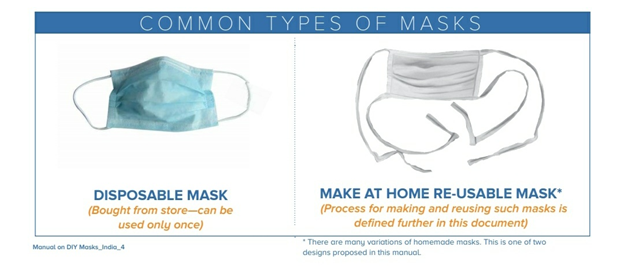

METHOD - To make Homemade mask
Method 1- make a homemade mask using a sewing machine-Any used cotton cloth including an old cotton vest or t-shirt can be used to make this mask. Color of mask does not matter.
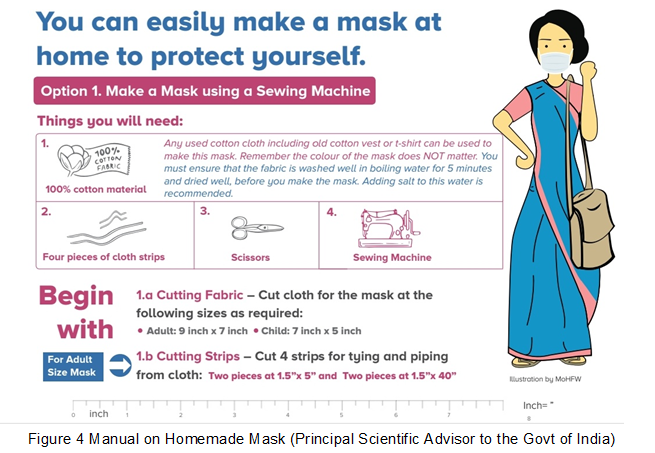
After the mask is ready, ensure that the mask fits around your mouth and nose and there is no gap between your face and the mask. When wearing the mask the side facing you should show pleats facing download. You must never reverse the mask for reuse. Always thoroughly wash the mask after every use.
METHOD -2 - Home made mask without a sewing machine
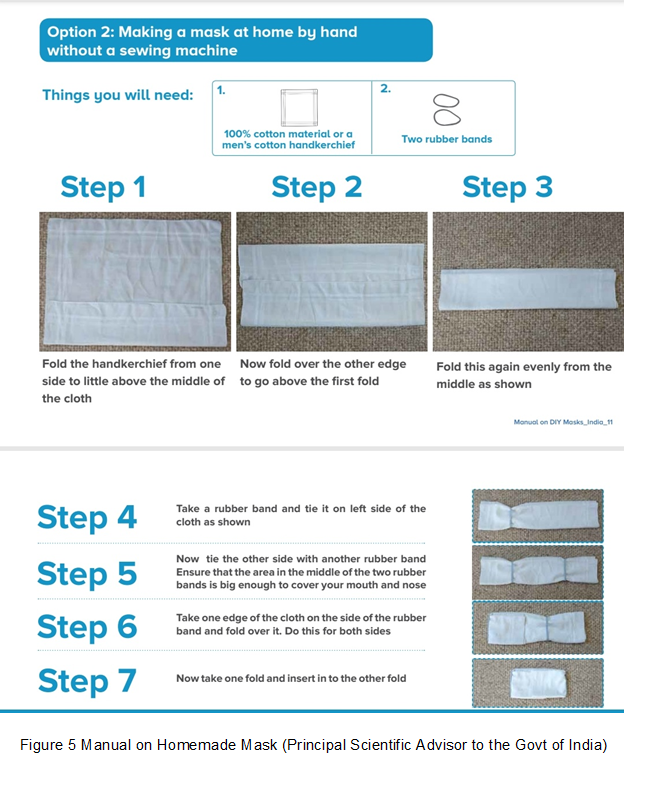
Important Precautions:
Before using the handmade mask remember:
- Thoroughly wash and clean the mask before wearing it.
- Wash your hands thoroughly before wearing the mask.
- As soon as the mask becomes damp or humid, switch to another mask and clean the used mask.
- Never reuse a mask after single use without cleaning it.
When removing the mask:
- Don’t touch the front or any other surface of mask, remove it only with strings behind.
- For string mask, always untie the string below and the string above.
- After removing immediately clean your hands with hand sanitizer (70% alcohol based) or soap and water for 40 seconds.
- Drop it directly into a soap solution or boiling water to which salt has been added.
How to clean and sanitize your homemade mask everyday:
- Thoroughly wash the mask in soap and warm water and leave it to dry in hot sun for at least 5 hours.
If you do not access to the sun, follow option 2. - Place the mask in water in a pressure cooker and pressure boil it for at least 10 minutes and leave it to dry. Adding salt to water is recommended.
If you don’t have access to a pressure cooker/boiling water follow option 3- - Wash and clean with soap and apply heat on the mask for up to five minutes. ( iron can use)
How to Store your Clean Mask:
It is recommended that you make two masks so you can wear one while other is washed and dried.
- Take any plastic bag and clean it thoroughly with soap and water.
- Let it dry well on both sides
- Keep your extra clean mask in this clean bag.
- Keep it sealed well and now you can rotate your mask for daily use.
How to choose a mask ?
The capability of masks to protect a wearer is ranked as follows:
N 95 respirator > Triple layer surgical masks > Homemade cotton masks.
COVID-19-Rational use of mask in different settings- source - MOHF, Directorate general of health services.
Masks are to be used based on the risk profile of health care workers
- N 95 Mask used in - ( Point of entry and Hospital )
- Help desk/Registration counter
- Triage area in OPD
- Doctors chamber in OPD
- Temperature recording station
- ICU facility/critical care
- SARI Ward
- Clinical management in isolation room
- Sample collection / testing for COVID 19
- Dead body packing/Transport
- Mortuary- while performing autopsy
- CSSD/Laundry-Handling linen of COVID 19 patients.
- Aerosol generating procedures e.g. Intubation
- Triple layer Surgical Mask -
- Visitors attending OPD
- Visitors accompanying patients in the IP family.
References-
- https://www.cdc.gov
- https://www.who.int
- Principal scientific advisor to the government of India.

